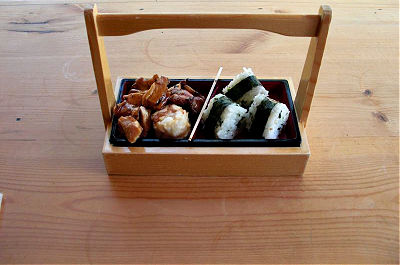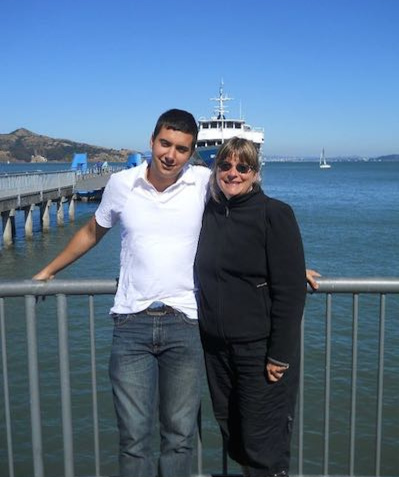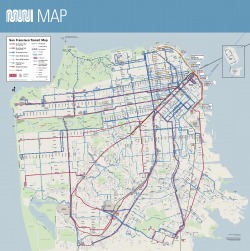- Home
- Golden Gate Park
- Japanese Tea Garden
Visit the Japanese Tea Garden
in San Francisco

Come and relax in the Japanese Tea Garden in San Francisco!
It is a popular tourist attraction, but it's still a peaceful and lovely place to wander.
The Tea Garden is definitely worth a visit; the locals love to come here as well. I started coming here as a young child and then brought my own child here, too.
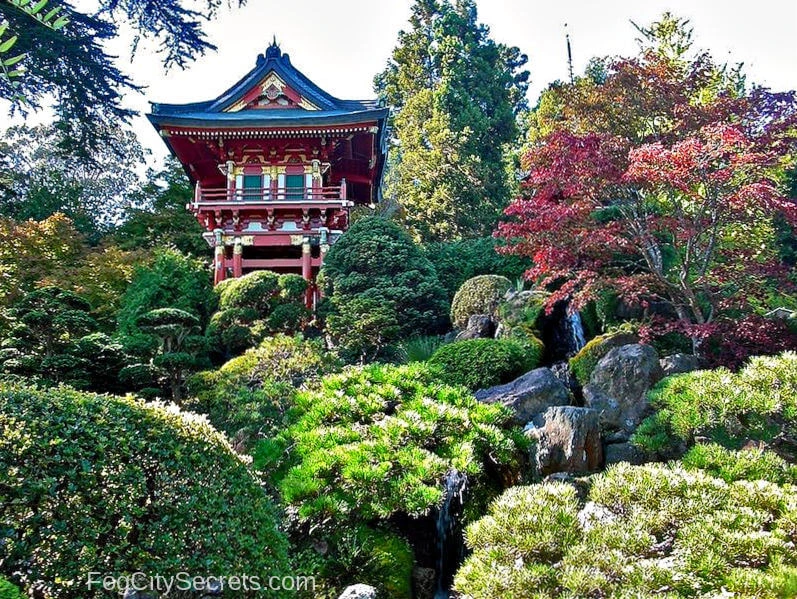 Temple Gate and Waterfall
Temple Gate and WaterfallThe winding paths travel across wooden bridges and stepping stones, past koi ponds and pagodas.
Enjoy the colorful temple gate, pagoda, peaceful Zen garden and acres of beautiful plantings.
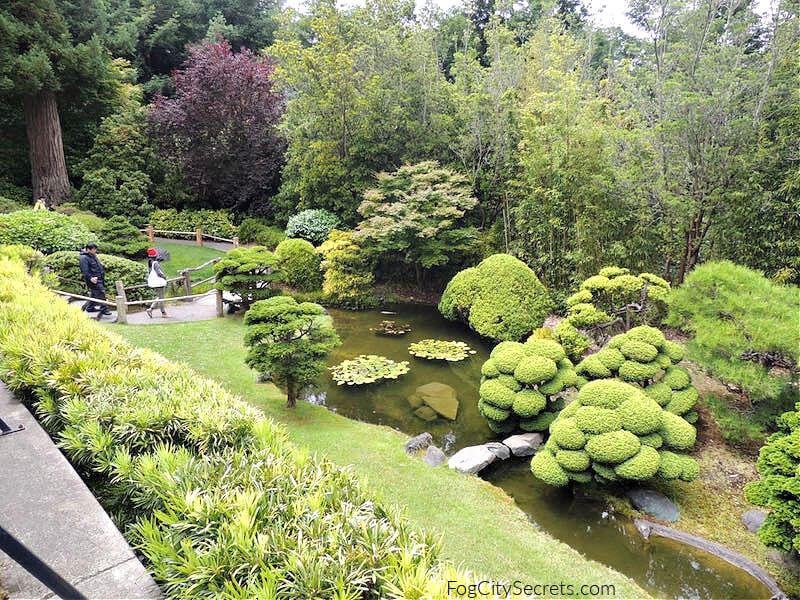 Pools and pathways
Pools and pathways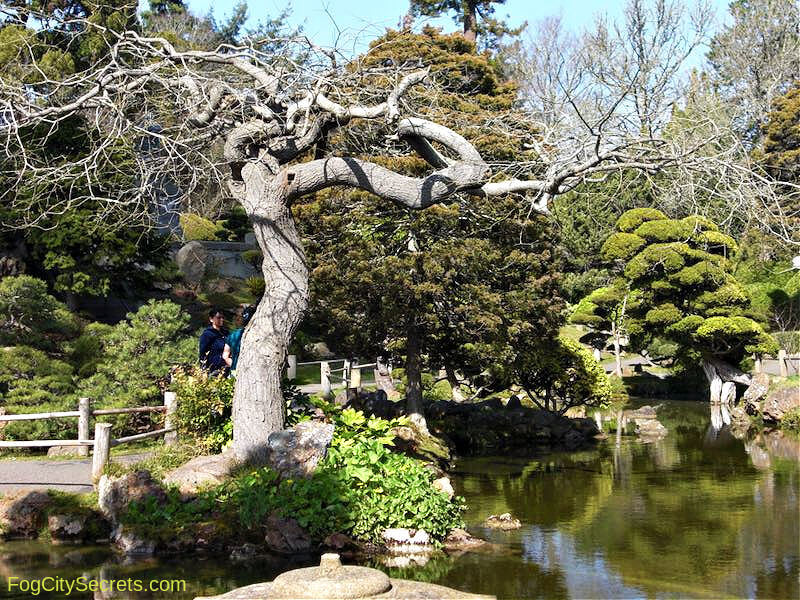 Tea Garden in winter
Tea Garden in winter
Insider Tips:
- Best Time to Visit the Tea Garden. Absolute best time is when the cherry blossoms are blooming, in March and April. Otherwise, sunny days, year round, are the best time to go, because it should be warm enough to enjoy the stroll through the gardens. The winters here aren't that cold (mid 50's usually) so if you're wearing a jacket, it's OK. The tea house is an open air building, no walls, so it will be the same temperature as the outside. Golden Gate Park is on the foggy side of San Francisco, so visiting during Fog Season (May, June, July) may be a bit gray and damp; but it does give it a rather mysterious look which is pretty cool, too.
- Best Time of Day to Go. Afternoons tend to be the most crowded, but if you avoid the prime lunch period (11:30 to 2:00) you shouldn't have to wait for a table at the tea house.
- Free Entry. You can get in free between 9 am and 10 am on Mondays, Wednesdays, and Fridays. SF residents and veterans are always free.
- What to Eat. The menu has changed again. The large assortment of snacks has been pared down, unfortunately, but it's still very pleasant to have some Japanese tea and snacks in the charming setting of the tea house. See the Japanese Tea Garden Menu.
- The Gift Shop. I'm not a fan of touristy gift shops, but the new managers have cleared out the piles of junky kitsch from the shop behind the Tea House and present a very attractive array of high-quality Japanese items, as well as some cool Japanese knick-knacks. The building for the shop (remodeled) is from the original Japanese Village of the 1894 Expo.
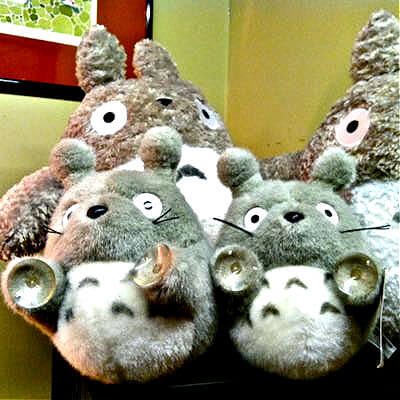 My Neighbor Totoro!
My Neighbor Totoro!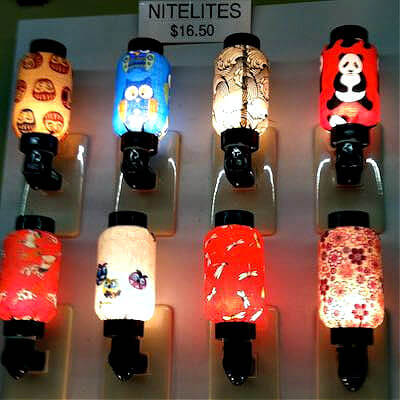 Night Lights
Night Lights- Things Have Changed. For those of you who visited over the past few years and were a bit disappointed in the Tea Garden, it is now under Japanese management again and it's back to what it used to be. You are greeted warmly, the tables are clean, and your tea is served with grace and courtesy. Also, the grounds are immaculate and the ponds are clear.
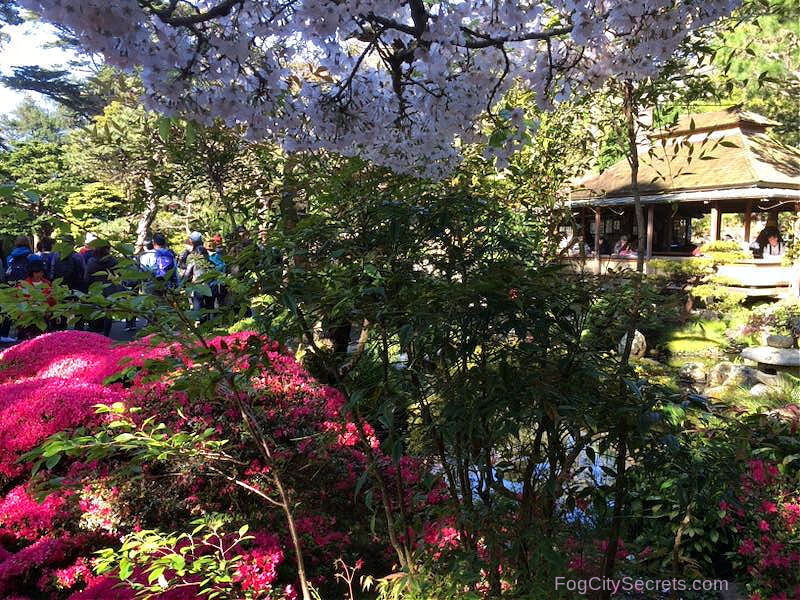 Tea House and gardens in spring...best time to go.
Tea House and gardens in spring...best time to go.Tea Garden Hours & Prices
Open daily.
Summer (Mar-Oct): 9 am to 5:45 pm.
Winter (Nov-Feb): 9 am to 4:45 pm.
Entrance Fees
Adults: $16
Ages 12-17 and 65+: $7
Ages 5-11: $3
Under 5: free
SF residents and veterans are free.
Entry is free between 9 a.m. and 10 a.m., Monday, Wednesday and Friday.
Cash, credit cards or Apple Pay.
You can also buy tickets online. Avoids the line on busy days, but adds a service fee of $3.75. 3-day pass is available for three gardens.
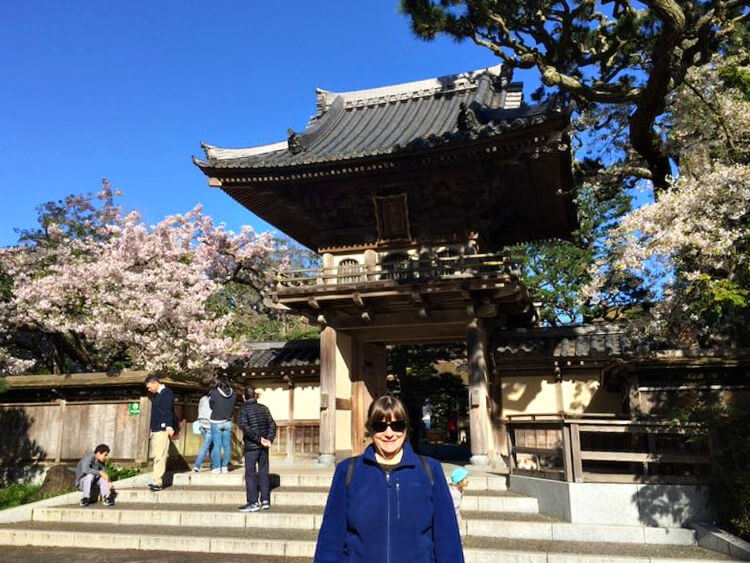 At the entrance to the Tea Garden, cherry blossom time
At the entrance to the Tea Garden, cherry blossom timeExploring the Garden
Things to look for at the Tea Garden:
- The pagoda and temple gate
- Waterfall hill and bonsai plants
- Large bronze Buddha
- Koi fish in the ponds
- Arching drum bridge
- Traditional Japanese Tea House
- Zen Garden
After entering the enclosure through the Japanese gate, take time to wander along the paths and over the bridges.
The exquisitely landscaped grounds cover five acres, so there are plenty of beautiful spots to explore.
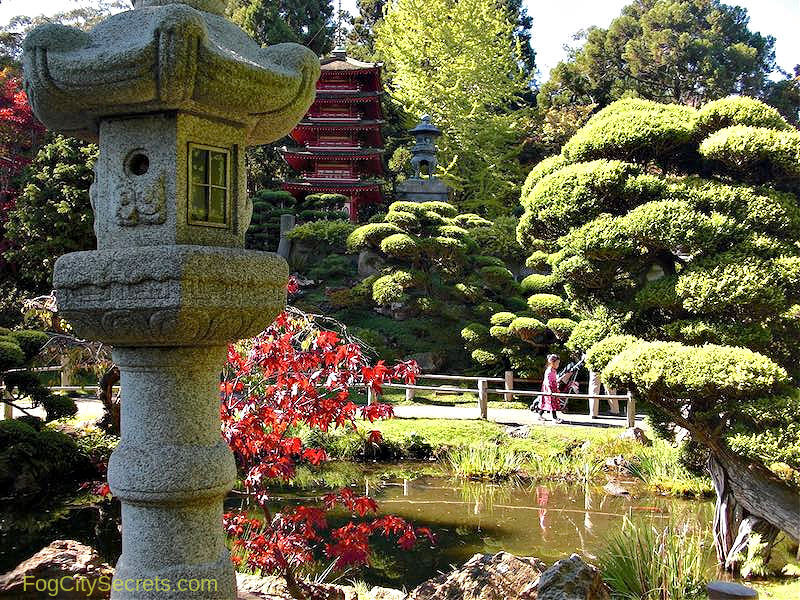 Tea Garden Pagoda and Lantern
Tea Garden Pagoda and LanternThe tea house overlooks a koi pond, surrounded by Japanese azaleas and bonsai trees.
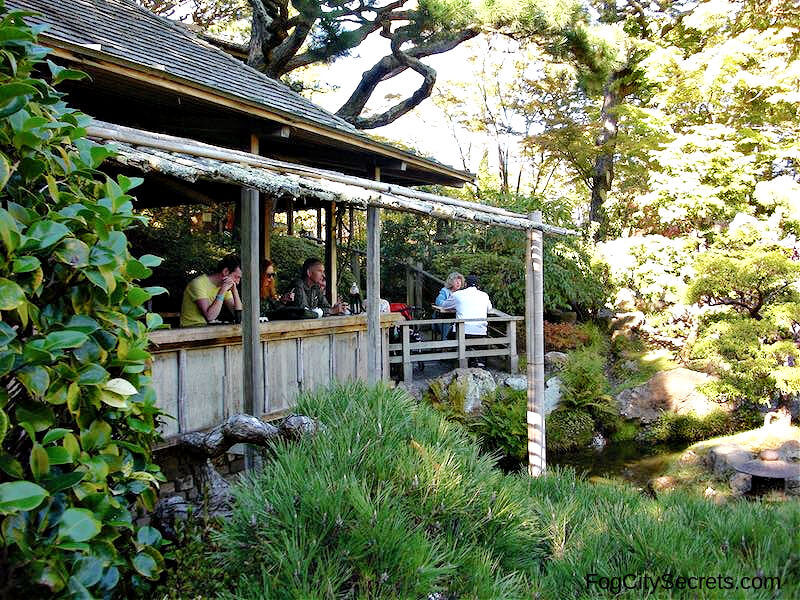 Japanese Tea House
Japanese Tea House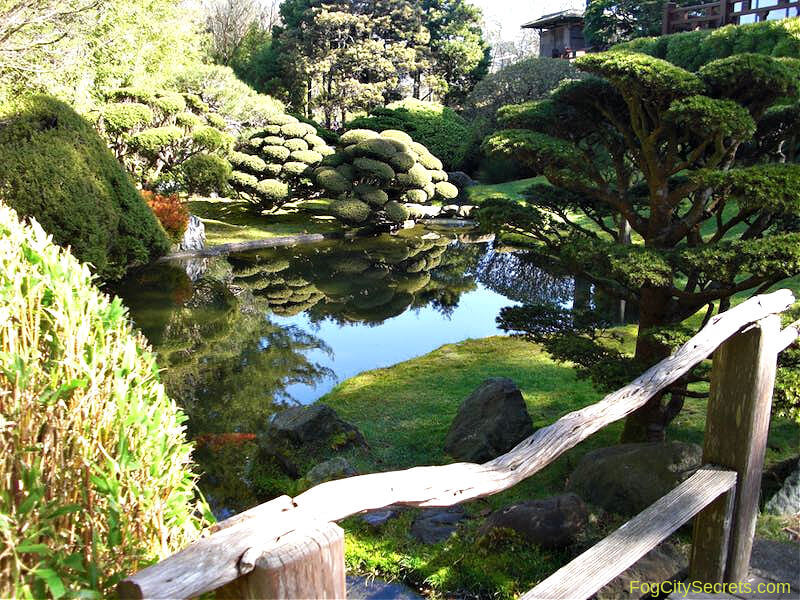 Tranquil Pond
Tranquil PondThe koi ponds are full of plump, healthy-looking fish in gorgeous colors- brilliant yellow and fiery scarlet, as well as the more classic patterns.
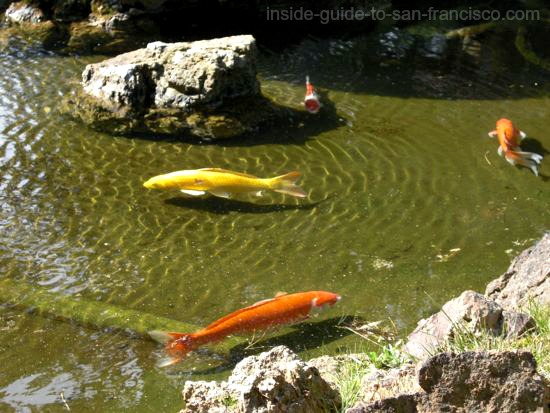
In an out-of-the-way spot, you will come upon a raked-stone Zen garden designed for peaceful contemplation.
On the upper level, an ornate Japanese temple gate leads into an area with a colorful pagoda, both created in 1915 for the Pan-Pacific Exhibition.
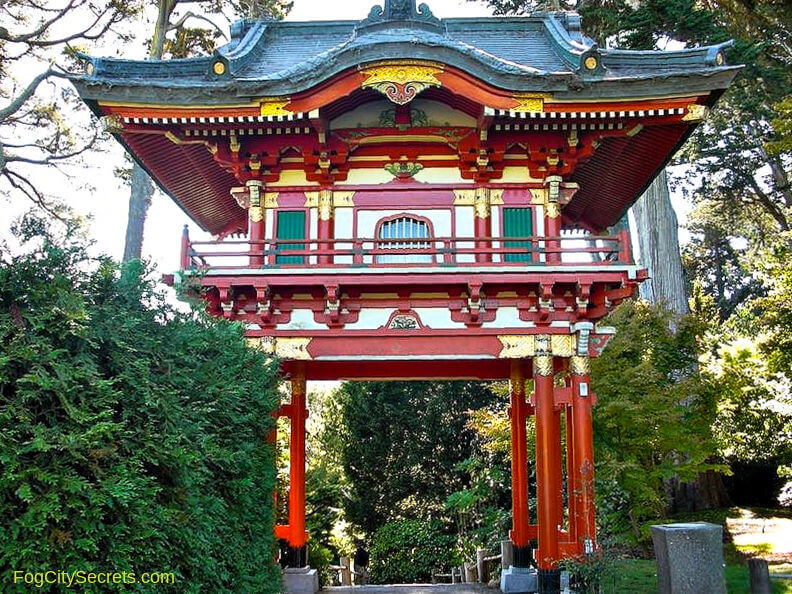 Temple Gate
Temple GateA bronze Buddha is nearby, cast in Japan in 1790, and donated by the Gumps Company in 1949.
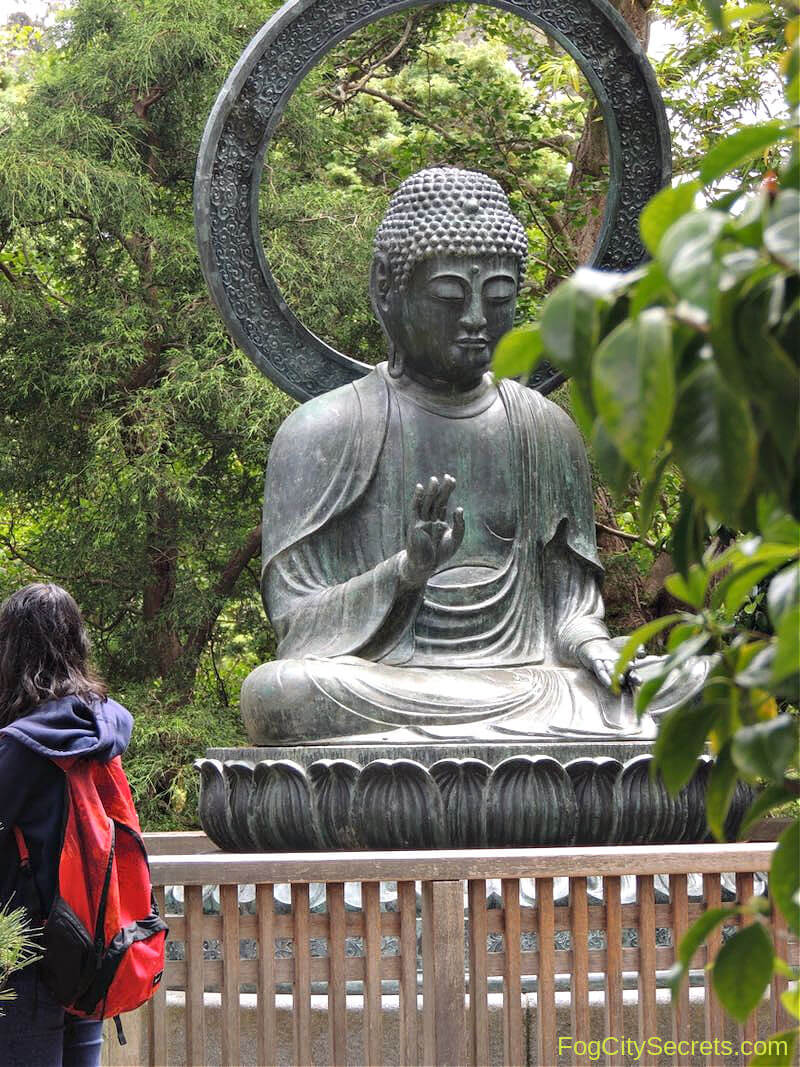 Bronze Buddha
Bronze BuddhaAs a child, I loved climbing the high arched drum bridge, and it's still a lot of fun! The color varies over the decades; I remember it being bright red in earlier years.
This bridge, also called a moon bridge, was built in Japan and shipped here in 1894 for the San Francisco Midwinter Exhibition. The name "moon bridge" comes from the round shape that appears when it's reflection in the water mirrors the arched bridge above it.
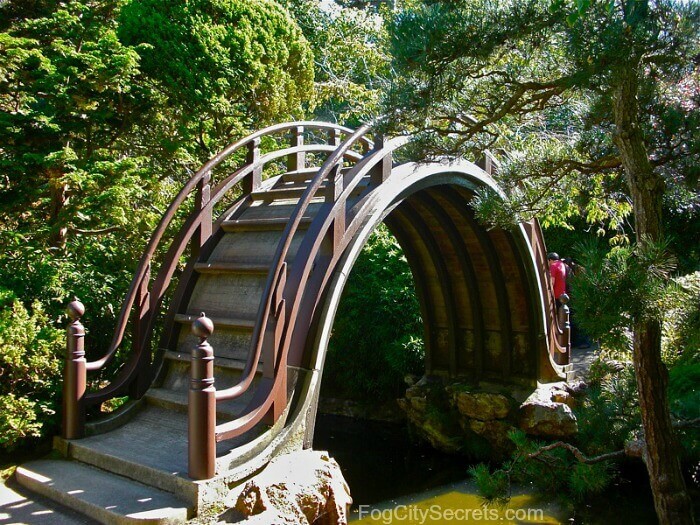 Drum Bridge
Drum Bridge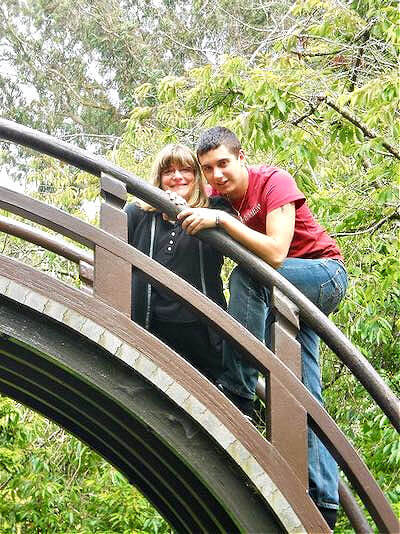 Mom and son (a few years ago)
Mom and son (a few years ago)There is such a feeling of peace in the garden, even on a busy day. The visitors seem to melt into the greenery.
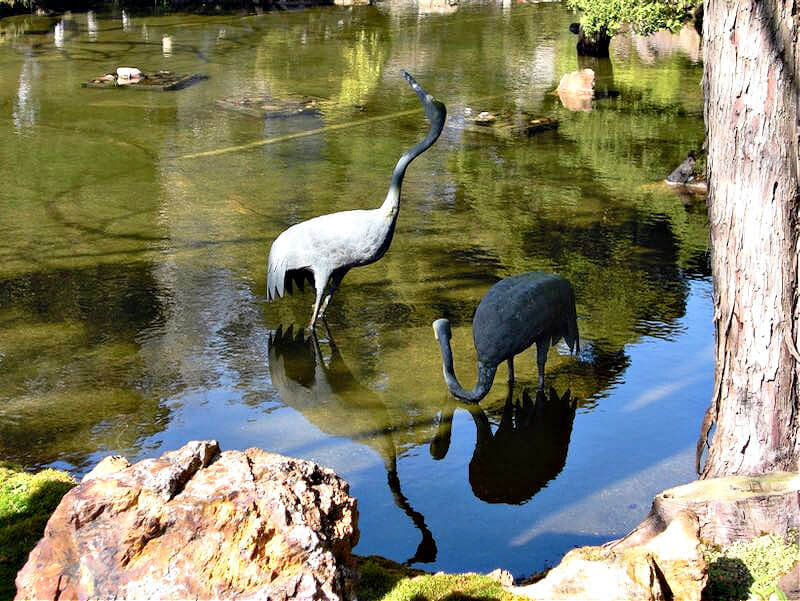 Cranes
Cranes Buddhist monks enjoying the gardens
Buddhist monks enjoying the gardensJapanese bonsai trees surround the waterfall below the pagoda.
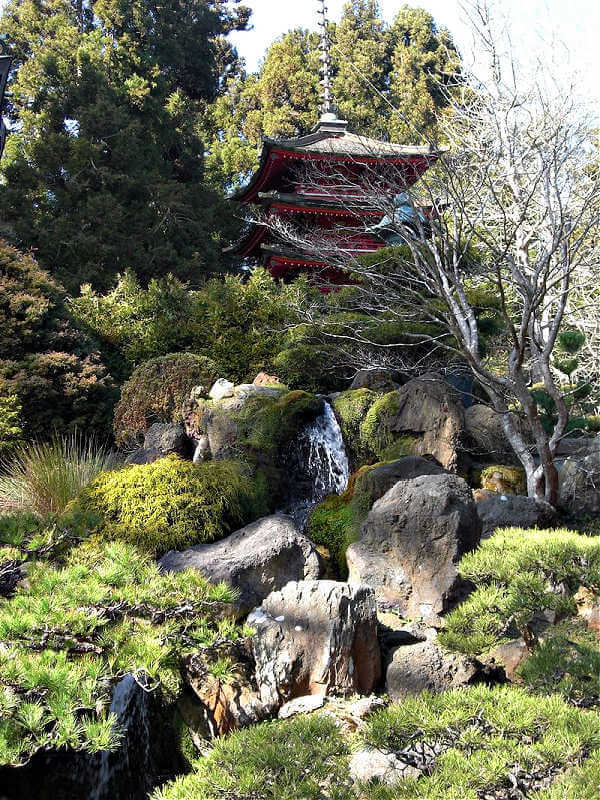 Waterfall and bonsai trees
Waterfall and bonsai treesThe Zen Garden was created in 1953, a traditional Japanese setting for peaceful meditation and contemplation. The design is intended to represent hills and a stream.
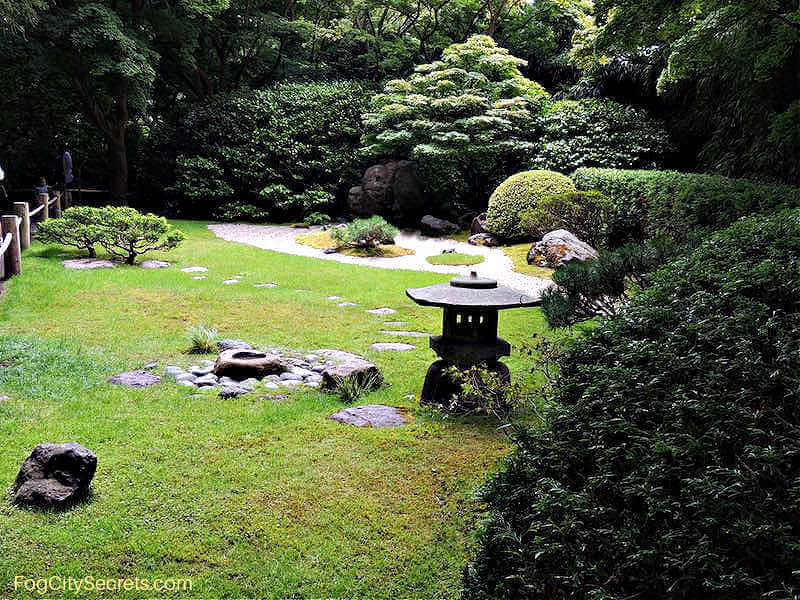 Traditional Zen Garden
Traditional Zen GardenTea Time in Old Japan
When you're done exploring, be sure to stop for tea and treats in the rustic Tea House overlooking a koi pond.
Have some fortune cookies at the place they were first served!
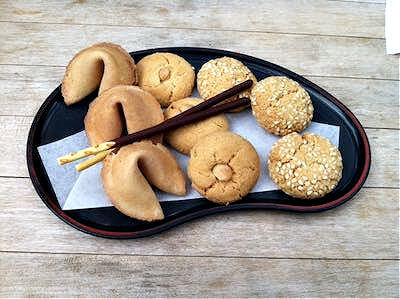 Cookies for Your Tea
Cookies for Your Tea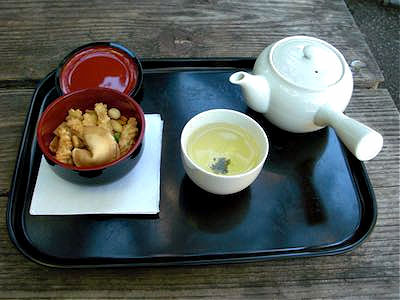 Tea and snacks
Tea and snacks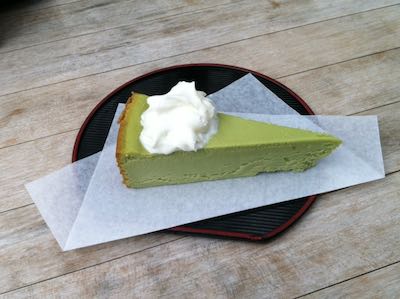
The Tea House has changed their menu again.
There's an assortment of traditional Japanese snacks and desserts to try out, along with some fruit-flavored Japanese children's drinks (Ramune) that you don't often see.
How about some green tea cheesecake; it's quite good!
Check out the current Japanese Tea Garden Menu for 2025, with photos of some of the choices.
Order and pay at the counter, and the server will bring it to your table.
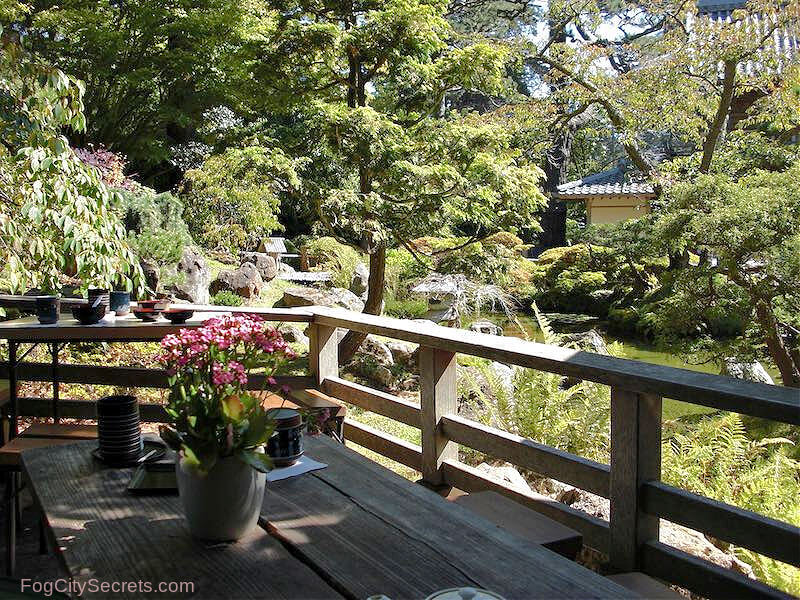 Tea House Patio
Tea House PatioHere is view of the last makeover for the tea house:
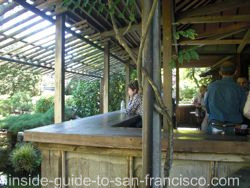 Tea House Before
Tea House Before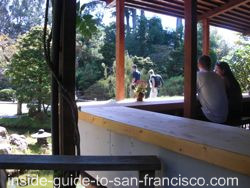 Tea House Now
Tea House Now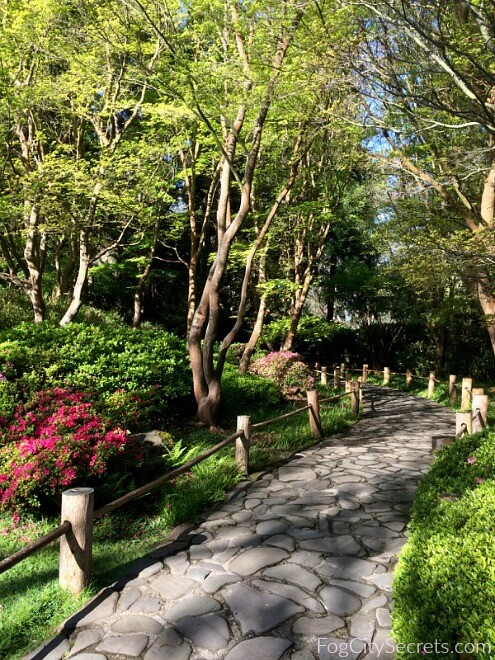 Inviting Pathways
Inviting PathwaysTea Ceremonies....
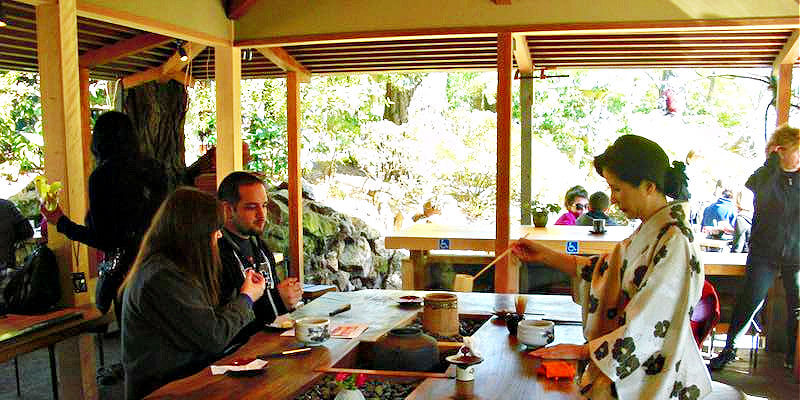 Japanese Tea Ceremony
Japanese Tea CeremonyThe tea house added a large table in the center designed for traditional Japanese tea ceremonies. The ceremonies aren't being offered at the moment; hopefully they will start doing them again!
The table is currently available for seating for larger groups.
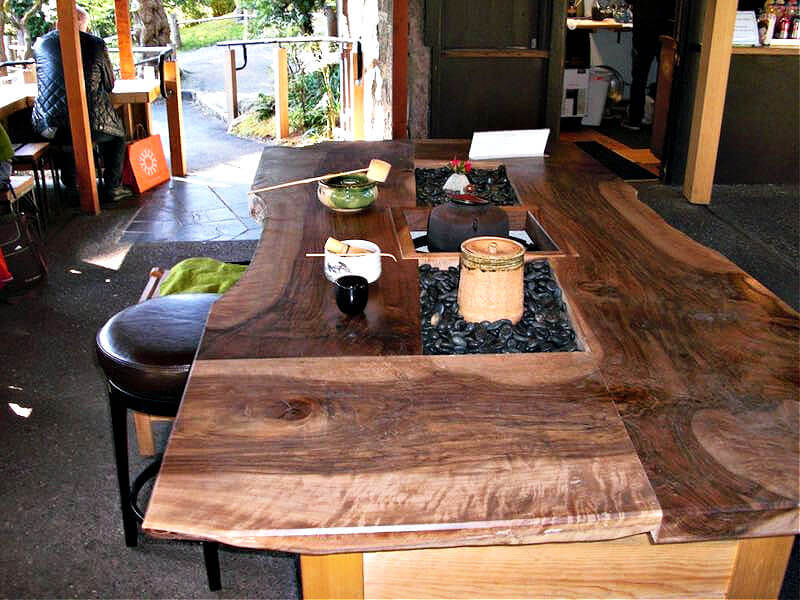 Ceremony table available for seating now
Ceremony table available for seating nowTea Garden Tours
There's a popular free tour of the Tea Garden given by the SF City Guides.
It's a one hour tour and is given most days, once or twice. You do have to pay to get into the garden (unless you fall under one of the exceptions, or you enter before 10 am). I haven't been on this one, but I have enjoyed a number of their other tours. Interesting and professional.
See SF City Guides Tea Garden tour for schedule and sign-ups.
History of the Japanese Tea Garden
It's the oldest formal Japanese garden open to the public in the United States.
The Tea Garden arose out of the Japanese Village exhibit built for the 1894 World's Fair in San Francisco (California Midwinter International Exhibition).
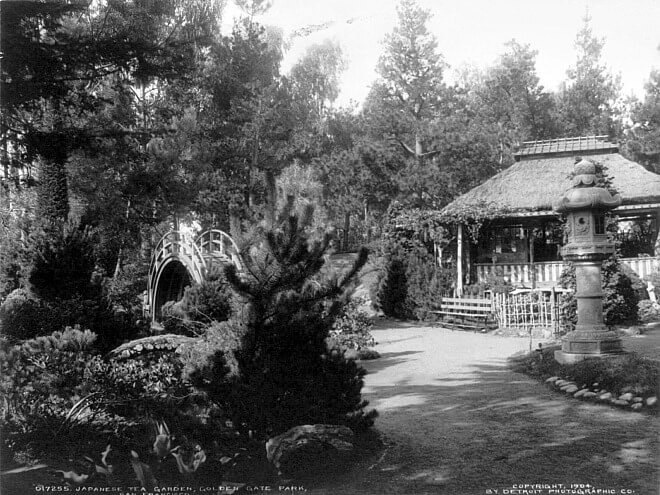 The Tea Garden in 1904
The Tea Garden in 1904Makoto Hagiwara, an immigrant from Japan, created an authentic Japanese tea garden in Golden Gate Park, contributing many valuable sculptures, structures and plants. He and his descendants were caretakers of the garden and lived there until 1942.
During the war, anti-Japanese sentiment led to the Hagiwara family being interned and the garden was renamed the Oriental Tea Garden. The garden went into a decline and many artifacts were stolen. After the war, the garden got its original name back and the street was named after Mr. Hagiwara.
For the previous fifteen years, the Japanese Tea Garden concession had been under other management, but in the summer of 2009, the garden returned to Japanese hands. Most of the servers in the Tea House are now Japanese (or Japanese-American).
There was an article in the San Francisco Chronicle about the controversy surrounding the change.
Origin of the Fortune Cookie.
The Japanese Tea Garden in San Francisco was also, oddly enough, the first place in the world to serve fortune cookies as we know them, although something similar had been sold in Japan many years ago and was probably the inspiration.
Mr. Hagiwara introduced the U.S. to fortune cookies around 1900, serving them in the tea house, and they eventually spread to Chinese restaurants in San Francisco, then all over the world. And they still serve them here: probably the only Japanese establishment in the U.S. that does!
The origin of fortune cookies was officially disputed. In 1983, the SF Court of Historical Review actually had a hearing on this issue and the Tea Garden version won. (The other claimant was a Chinese business, the Hong Kong Noodle Company, in Los Angeles.)
How to Get to the Japanese Tea Garden
The address is 75 Hagiwara Tea Garden Drive.
The Tea Garden is next door to the de Young Museum on the Music Concourse, near the California Academy of Sciences in Golden Gate Park. See map.
By Bus...
- 44 O'Shaughnessy bus. Stops at the Tea Garden inside the park.
- 5 Fulton bus. Get off at 8th Avenue, walk into the park and turn right on JFK Avenue. Go past the de Young Museum.
- N Judah streetcar. Get off at 9th Avenue, walk into the park on 9th, then right on Hagiwara Tea Garden Dr.
- From Fisherman's Wharf. Take the F-trolley to Market Street, then the N Judah streetcar (underground Muni) to 9th Ave. Walk into the park on 9th, then right on Hagiwara Tea Garden Dr.
- From Downtown. Go into one of the downtown Muni stations (underneath Market Street) and catch the N Judah. See above.
By Car...
The Japanese Tea Garden is on Hagiwara Tea Garden Drive between Blue Heron Lake and the de Young Museum.
You can enter Golden Gate Park on the south side via 9th Avenue.
Parking for the Tea Garden
Parking can be tricky, especially in summer and on sunny weekends.
There is a parking garage underneath the de Young Museum nearby, with two entrances: one entry off Fulton Street at 10th Avenue, and another at the west end of the California Academy of Sciences on Concourse Drive, just off MLK Jr Drive. ($ 2.25/hr Mon-Fri; $3.25/hr Sat-Sun. VISA, MC accepted.). Marked on map below.
Ideas for parking spaces: there can be spaces on Martin Luther King Drives on either side of the Tea Garden (JFK is now permanently closed to cars in that area).
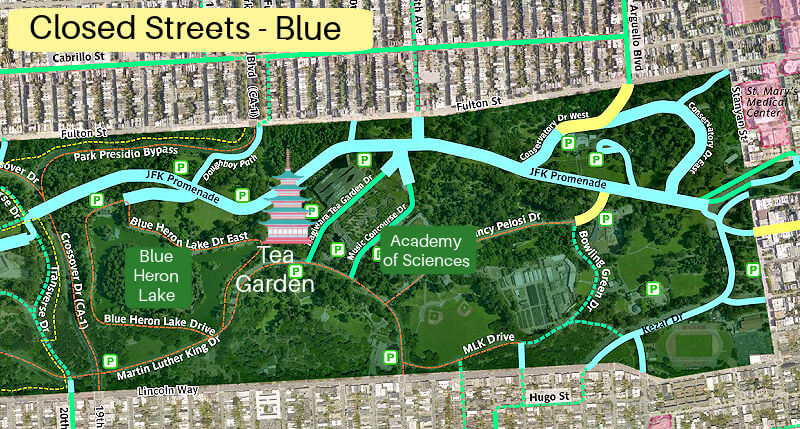 The blue streets are closed to cars
The blue streets are closed to carsThere is no parking on the road that goes past the Tea Garden (Hagiwara) and loops around past the Academy of Sciences and the de Young Museum.
Another possibility is street parking outside the park near 9th Ave on the south side of the park, but parking in that neighborhood is tough.
Fallback parking suggestion: If the streets near the Tea Garden are packed, try parking around Blue Heron (Stow) Lake; there are almost always places available around the loop. It's only about a 10 minute walk from there.
Maps of the Japanese Tea Garden
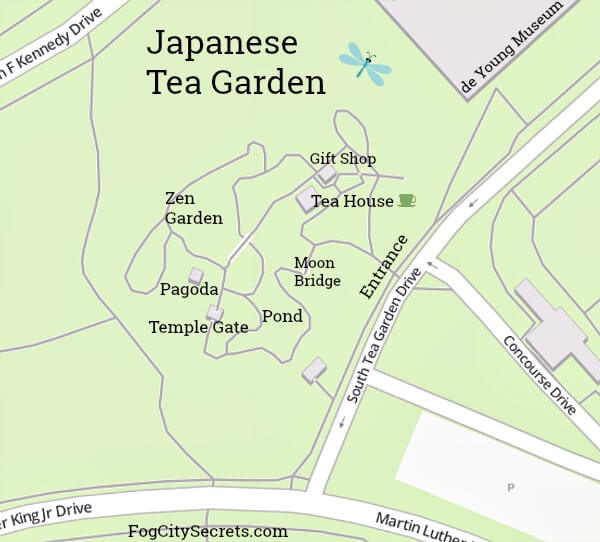
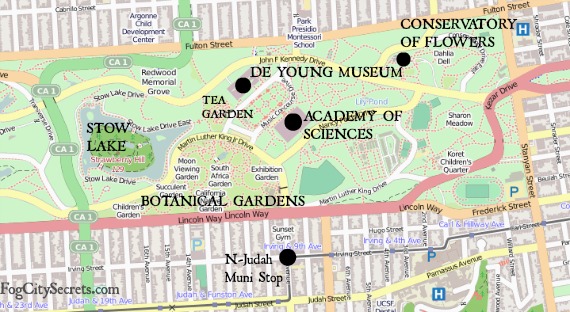
Discover all the fun things to do in the park in my Complete Guide to Golden Gate Park. Main attractions and hidden gems.
The Japanese Tea Garden Menu.
Take a look at the list of menu items and photos, and recommendations.
More Sushi!
Looking for a good sushi restaurant near Golden Gate Park?
You See Sushi is a cheap and tasty sushi place near UCSF (and walking distance from the Tea Garden).
More Gardens...
 Shakespeare Garden
Shakespeare GardenGolden Gate Park has lots of other gardens to explore.
Visit the Rose Garden, Redwood Grove, Shakespeare Garden, and more.
For info, garden maps and photos, see Gardens in Golden Gate Park.
Visit Japantown
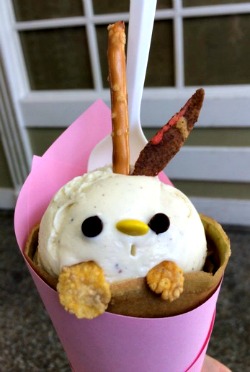 Japantown Crepes
Japantown CrepesSan Francisco has one of the three remaining Japantowns in the U.S.
This is a cool neighborhood to explore and less touristy and crowded than Chinatown.
You can check out the authentic Japanese shops and restaurants in Japantown.
Nearby attractions...
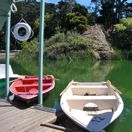
Rent boats at Blue Heron Lake (formerly Stow Lake) in Golden Gate Park.
Choose a row boat or paddle boat and sail around the island. See Blue Heron Lake.
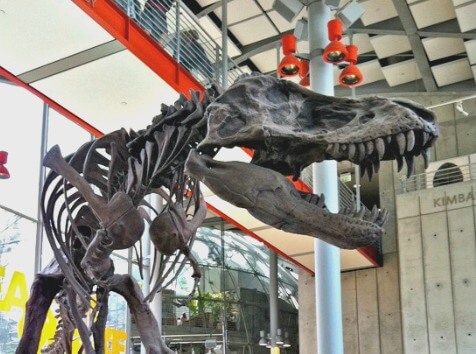
Explore a first-class, science museum at the California Academy of Sciences.
Just across the street from the Tea Garden and deYoung Art Museum.
It's a natural history museum, aquarium and planetarium in one building. See Academy of Sciences Museum.

Visit one of San Francisco's largest fine arts museums.
The de Young Museum is in Golden Gate Park, right near the Tea Garden and Academy of Sciences museum.
See de Young Museum.
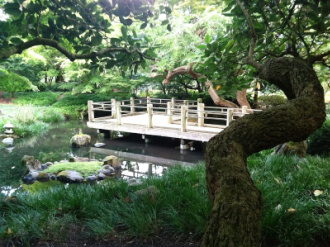
Explore San Francisco's botanical gardens, acres of beautiful plantings and inviting paths.
A short walk from the Tea Garden you'll find the entrance.
See Botanical Gardens.
Share this page:
